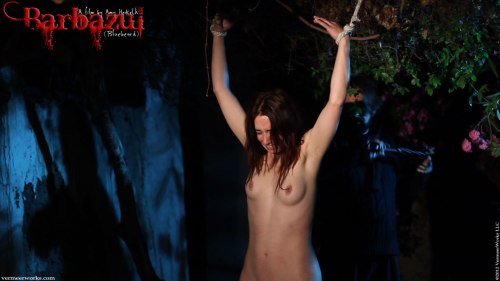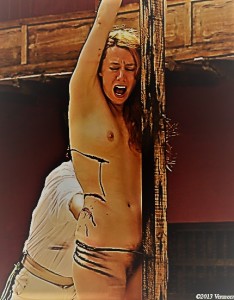by Rich Moreland, September 2020
This is the second installment on Jac Avila’s latest project, a series of vignette films titled CruXtreme.
My thanks to Jac and Red Feline for the photos that appear here.
* * *
No Independent Cinematographer
While seemingly unsophisticated at first glance, the cinematography in CruXtreme I (CX I): The Playroom is actually quite innovative considering the limited space of the set and the fact that there is no independent cinematographer. Cameras are situated to capture the whip induced agonies from different angles and positions, reminding us that the editing was a challenge. Near the end, the camera does some sweeping views of the film’s star, Daniela Borda, but they are minimal.
In my discussions with the film’s creator, Jac Avila, he was honest in his assessment of the tasks he and Dani faced with the film.
“The Playroom is more a performance than a film with a plot. It has a plot, sure, but very thin,” he began.
“It was made just by the two of us, Dani and myself. I do the work of setting up lights and the camera and all of that which is manual labor, of course, and tiring, lots of moving around and carrying things within the span of a couple of hours.
“Dani took care of her personal make up. All the [other] make-up effects were done by me.”
Those include the bloody marks on her body.
Jac continued with his praise of Dani contributions.
“She helped me with the set, moving things around and the decor. I used some of the music I have in our archives, the opening piece was also used in other films, Pygmalion, amongst them. That’s the Bach piano melody,” he said.
Together they did a most credible job.
One-Man Crew
For fans with a technical interest in filmmaking, Jac elaborated on what it’s like to work within a confined environment. By the way, he references CX I’s follow-up films, CX II and CX III.
“For the first two films in this series I used only one camera which I had to move a lot for all of the angles I have on each scene, I used a tripod and a crane, depending of the kind of shot I wanted.
“In the current film (CX III) I’m using two cameras, the Canon that I move a lot, setting it up on the tripod or the crane, depending on the kind of shot I want, and a 4K GoPro that [is] above the cross to get a bird’s wide angle view of the scenes.”
We talked a little about some of the muffled dialogue which is difficult to understand. It’s a concern, Jac pointed out.
“One of the problems with working as a one-man crew is that I have to do everything, so I don’t have a sound person to make sure everything is coming along well. I record the sound both with the built-in camera mike and with a separate professional sound recorder with a great Sennheiser mike set up in a boom. But I can’t use my earphones to hear what is happening.
The mike is set up so that Dani can be heard “because she’s the focus of the story,” Jac explained. Unfortunately, “my voice muddles a bit,” he added.
Despite the technical shortcomings, CX I is a remarkable success.
Three is a Risk
As we’ve mentioned above, there are at least two more films in the works on this theme: CruXtreme II and III. They are also the joint efforts of Jac and Dani.
According to Jac, Dani loved working on the series despite the horrors she apparently endures.
“She commented to me, recently, that she’s having a lot of fun,” he said.
It’s clear that her enthusiasm for the “victim” role is genuine.
“When I told her that we were almost done with the third one, she said that she has mixed feelings. She wants to finish it because she wants to move on to the next movie, while she doesn’t want to finish it because she’s enjoying it too much.”
Though they will wrap up the third installment soon, the pandemic is playing havoc with their schedule, as might be expected. Jac emphasized that they are faced with a one-week lock down in LaPaz. As a result, they’ll be forced to take that week off.
“If we’re done with CX III, we’ll move on to work on a couple of films with Mila [Joya] where Dani will also play a part,” he added.
Covid19’s toll is evident, however.
“Because of the pandemic, the team has come down to two people, and soon we will be three [when Mila is on board],” Jac said. “That’s it. We can’t have more people working. Even three is a bit of a risk. We’re taking all the precautions, but still.”
Among those precautions is a limited time frame to complete the shooting.
“Our work schedule is two hours a day, two or three days a week. We have long stretches without working or seeing each other, so if anyone of us shows any symptoms, we would cancel further plans.
“Awful times indeed,” he lamented.
Alas, the Tattoo Parlor
Finally, Red Feline fans will be disappointed to learn that the impressive dungeon used in recent productions is no more. Jac let us in on the back story.
“Soon after the release of Justine, I was contacted by Dani who had seen Justine and decided that she wanted to work with me in films like that. I had just finished shooting The Passion of Isabel with Bea (Beatriz Rivera) and had the set with all the props for a few more days, so she (Dani) came over for a test and I was very surprised that she did not have any problems getting all undressed to be chained up and mistreated for a casting test.
“Sadly, I had to leave the set, it was already taken over by a tattoo parlor. I could’ve made lots of new films there. I used it in Maleficarum, Le Marquis, Justine and The Passion of Isabel.”
“During the rest of this year I’ll be busy with Dani, Mila and probably Simonne [del la Riva] but mostly with Dani.”
Despite the loss of a great set, I’m sure Jac Avila’s innovations will impress Red Feline’s fans with more terrific and sadistically titillating movies.
* * *
To download the CruXtreme series or order it in a DVD format, head to Vermeerworks.
If you have not yet purchased the tortured female BDSM horror classics Jac mentions here, scroll through the Vermeerworks catalogue for ordering.
And, if you are so inclined, reviews of other Jac and Amy feature films appear in the archives of this blog.



























































































































